Gladiolus robertsoniae
Gladiolus robertsoniae F.Bolus
Family: Iridaceae
Common names: Robertson’s sword lily, Robertson’s gladiolus. (Eng.)
Introduction
Gladiolus robertsoniae is a rare endemic species from the southern highveld, easily recognised by its striking and attractive, bright white or pale lilac, fragrant flowers.
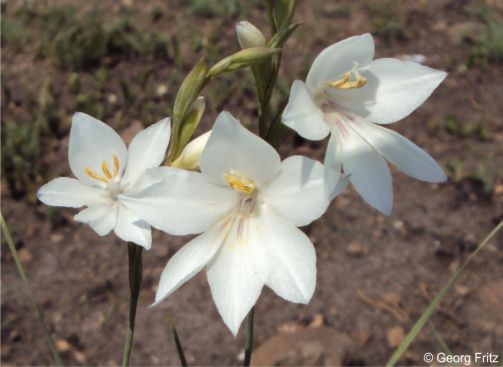
Description
Description
Gladiolus robertsoniae is a deciduous bulbous plant that grows 200-450 mm in height. Its rootstock is a corm (swollen underground stem) with a fleshy, rounded to oval (globose) shape that serves as a storage organ for nutrients. The corm is between 14-18 mm in diameter and is covered by medium-textured and wiry reticulate fibres. The corm can remain viable for several growing seasons and is capable of re-emerging after being lifted and stored for several months. The stem is erect and occasionally has one branch. It is curved or slightly bent (lightly flexed) above the sheaths of the upper 2 leaves, with a diameter ranging between 1.2 and 1.7 mm below the spike. The outer sheath is brown and thin, easily drying out and quickly falling apart. The inner sheath is transparent, slightly rounded or pointed at the edges, and measures 18 to 80 mm in length. The plant has a rapid growth rate, making it suitable for quick seasonal displays. It has 3-4, long and narrow (linear), sword-like leaves that are soft in texture. The two lower basal leaves are the longest, reaching up to 160 mm in length and 2-4 mm in width. The midrib is moderately thickened with slightly raised margins. The upper cauline leaves are shorter and more sheathing. The inflorescence is a slightly tilted spike that produces flowers on each segment. At the base of the spike, it has dark green bracts (leaf-like structures) sometimes flushed with purple. The outer bracts are 16 to 18 mm long, while the inner bracts are shorter or almost as long, with a notched apex. The spike typically bears 4 to 8 small, fragrant flowers that are mauve or white, with a hint of soft purple to pink (pale lilac). The flowers are shaped like a shallow dish, with a tube at the base and petals that spread out flat (salver-shaped). The three lower lobes of the flowers are speckled or striped with red or mauve near the base. The perianth tube is 28-50 mm long, curves outward below the mouth, and is longer than the lobes. The flower is typically 30-40 mm in diameter. The flowers bloom in spring to early summer (from October to December) and emit a sweet, spicy, clove-like or carnation-like fragrance, which persists both during the day and at night. The fruit is a rounded capsule, 10-14 mm long, containing egg-shaped (ovate)seeds that have broad, irregular wings surrounding them. The seeds are small, pale brown, measuring 5-6 mm in length and 3-4 mm in width.
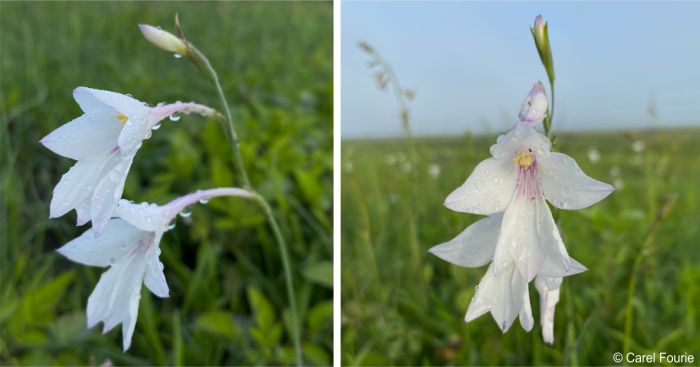
Conservation Status
Status
According to Red List of South African Plants, Gladiolus robertsoniae is Near Threatened (NT). It is a rare species, known from between 10 to 20 sites, and its population continues to decline due to habitat degradation caused by mining activities and overgrazing by cattle.
Distribution and habitat
Distribution description
Gladiolus robertsoniae is a South African endemic, summer-rainfall species that is found in three provinces: the highveld regions of southeastern Gauteng, northeastern Free State and southwestern Mpumalanga. It occurs in the Grassland Biome, in Soweto Highveld Grassland, Frankfort Highveld Grassland and Amersfoort Highveld Clay Grassland habitats, primarily in wet, rocky sites, particularly dolerite outcrops and along drainage lines or seeps, often wedged in rock crevices. The habitats of this species are characterised by high moisture retention.
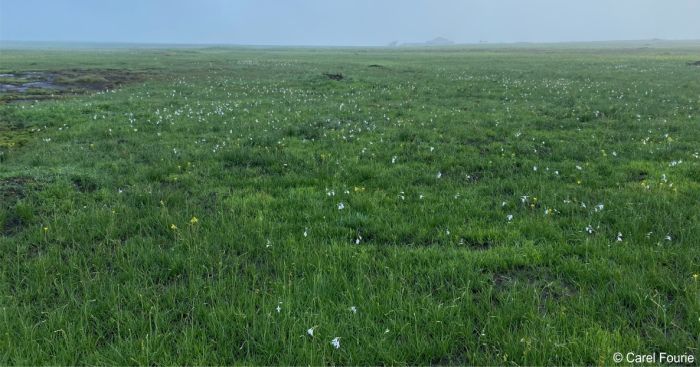
Derivation of name and historical aspects
History
The genus name Gladiolus is derived from Latin and means a small sword, referring to the shape of the leaves. The specific epithet robertsoniae honours W.M. Robertson, who made the first recorded collection of this species in 1916.
The genus Gladiolus is widely distributed across southern Africa, through tropical Africa and Madagascar to Europe, the Middle East and regions bordering the Mediterranean. It includes 296 accepted species, with 169 species recognised and indigenous in southern Africa. The genus has undergone three revisions and continues to be studied by botanists. There are 71 species endemic to the Western Cape winter-rainfall region, and 10 species that occur only in Mpumalanga.
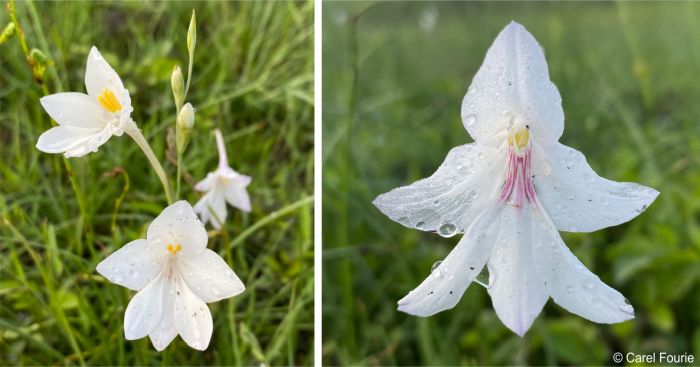
Ecology
Ecology
Gladiolus robertsoniae is found in the Grassland Biome of the southern African summer-rainfall zone. Its ecological role includes stabilising soil in its natural habitat, particularly in moist grasslands. Its underground corm enables it to survive the cold, dry winter conditions, and fires. Its fragrant flowers attract pollinators, contributing to the biodiversity of its environment. South African Gladiolus species are pollinated by diverse pollinators, including sunbirds, noctuid- and hawk-moths, and long-tongued flies. The pale colour and sweet and spicy night fragrance of Gladiolus robertsoniae flowers indicates that the primary pollinator is most likely a moth.

Uses
Use
There are no recorded medicinal or cultural uses for Gladiolus robertsoniae and it is not well-known in horticulture, however, several other similar species of Gladiolus are cultivated successfully in grassland gardens and containers, suggesting that G. robertsoniae may also have ornamental value under similar conditions. Because of their beauty, many species, cultivars and hybrids of Gladiolus are widely used in horticulture, planted in herbaceous borders, beds and rockeries, in pots, and grown and sold in markets as cut flowers.
In Africa, some species, notably Gladiolus dalenii, are used in traditional medicine for treating many ailments including diarrhoea, chest ailments associated with sorcery, to facilitate placental birth in women, to treat wounds, eye infections, ear infections, and other conditions, and to reduce pain during menstruation. In some African countries, Gladiolus dalenii corms are consumed as a food source. In many countries gladioli flowers are used in ceremonies, celebrations and funerals. Gladiolus is regarded as the birth flower of August and is associated with the 40th wedding anniversary. In the Netherlands, participants who complete the international four-day marches in Nijmegen receive gladioli as a symbol of victory.
Growing Gladiolus robertsoniae
Grow
The authors have no firsthand experience with growing or propagating this species. The information presented is based on recommendations found in the literature and online resources. This highlights the limited documentation and lack of applicable propagation techniques, which in itself poses a challenge and potential threat to the species, looking its current conservation status.
Gladiolus robertsoniae thrives in full sun but can tolerate partial shade. It needs well-draining soil ranging from sandy loam to clay loam, with a slightly acidic pH between 5.5 and 6.5. To promote healthy growth, ensure that compost (humus) is mixed in before planting or applied as a layer of mulch to add nutrients. Sand can be added for improved drainage. To achieve optimal growth, it is essential to maintain even moisture in the soil, watering once a week during spring and summer, especially if rainfall is less than 25 mm. It's best to plant in temperatures of around 16°C to prevent corm rot. When the leaves start to die back at the end of summer, reduce watering and stop watering while they are dormant, during winter. Resume watering in spring.
Gladiolus robertsoniae is best propagated from seeds sown in spring or early summer. After the seed pods dry and crack, seeds can be collected. Carefully extract the seeds and dry them; tissue paper can absorb any remaining moisture. The dried seeds can then be stored in zip-lock bags and kept in the refrigerator until the following spring, or can be sown immediately. For sowing, prepare a free-draining sterile sowing mixture, such as one of coir peat, sand and vermicompost in equal parts, adding a teaspoon of fungicide powder to the mix. Use a 7 cm deep container with drainage holes or seedling trays for planting. Ensure that each seed has adequate space between them. To begin, cover the drainage holes with broken pieces of clay pots and fill the container with the prepared mix until it is a quarter full. Water the mix before placing the seeds on top, then cover the seeds with a thin layer of the same mix, ensuring they are not buried too deeply. Water again gently. If sunlight is harsh, keep the pot in partial shade; if sunlight is normal, place it in full sun. The seeds require continuous moisture; if the mix dries out, the seeds will not germinate, or the bulbs will not grow to their full potential. However, avoid excessive watering, as a soggy mix will result in poor germination. It’s important to keep the mix consistently moist.
When the shoots emerge in spring, apply a liquid fertiliser to increase chances of survival. Avoid high-nitrogen fertilisers, which may lead to excessive leaf growth at the expense of flowers. After the flowering season, allow the flowers to fade and mature into seed pods. Once the pods turn brown and dry out, you can then harvest them. After the seed pods have been collected at the end of the growing season, you can cut back the foliage to ground level unless bulbs are dug up for winter storage. Delaying trimming allows the plant to store more energy in the bulbs, leading to healthier and larger corms for future growth. In very cold climates, Gladiolus species should be treated as annuals, digging up bulbs after the first frost and storing them in a cool, dry place for winter.
Most Gladiolus can be propagated through corms, divisions, cormels, and seeds. To plant Gladiolus, begin by preparing the soil, loosening it to a depth of 300 to 380 mm and incorporating a 50-100 mm layer of aged manure or compost for improved fertility. Select healthy corms and plant them with the pointed end up, with sufficient spacing between each. Gladiolus can be planted in rows for cut flowers, or in groups in borders among other flowers, for the best effect of massed flowers. The corms from the plants can be planted directly in the garden in early spring, after the danger of frost has passed, or started indoors four to six weeks before the last frost date for an earlier growing season.
Most gladioli can be propagated through division, which can be done in autumn (March-May), when all the foliage has withered but before the first hard frost. Lift the corms, shake off the soil, and separate them for replanting. Large corms may bloom the following year, while smaller ones can take two to three years to flower.
Many gladioli can also be propagated through sections, where the corms are lifted and then sliced straight down through the basal plate to create sections. Each section should cure and form a callus before planting in the following spring. Depending on the size of the corm, the large sections may produce flowers as soon as the following year.
Be careful of pests such as thrips (Thysanoptera), which can cause browning and speckling on the foliage. If necessary, these pests can be treated with insecticidal soap or spray. Aphids (Aphidoidea) feed on the sap of tender leaves, emerging spikes and florets. Mites (Tetranychidae) pose a challenge as they infest the corms, causing damage to the leaves and buds. These can be managed by using suitable pesticides.
Diseases such as Fusarium yellows (vascular disease or core rot), caused by Fusarium spp., may result in discrete brown lesions, rotting of plant roots, and leaf infestation. This can be addressed by dipping the corms in a suitable fungicide after harvesting and before storage. Grey mould (Botrytis cinerea) can cause brown spots on leaves. To control this, remove and destroy old flower spikes. A hot water treatment (52° Celsius) of corms, with fungicide added to the water, is effective in eradicating the pathogen.
References
- Baker, J. 2017. Gladiolus Thrips PDIC Factsheets. NC State Extension Publications. https://content.ces.ncsu.edu/gladiolus-thrips.
- Bhagat, S.S., Gupta, S.T., & Ingle, S. 2018. Study on isolation, purification and identification of gladiolus disease. International Journal of Chemical Studies 6:1554-1558.
- Biodiversity Explorer. Gladiolus. https://www.biodiversityexplorer.info/plants/iridaceae/gladiolus.htm. Accessed 10 July 2025.
- Burkill, H.M. 1985. Gladiolus dalenii Van Geel. Useful Plants of West Tropical Africa. Accessible via JSTOR Global Plants https://plants.jstor.org/stable/10.5555/al.ap.upwta.2_891.
- Chandrashekar, S.Y. 2011. Gladiolus Breeding Guide. https://www.scribd.com/doc/101814163/Gladiolus-Breeding-by-Chandrashekar-S-Y. Accessed 9 Jun 2025.
- Duncan, G. 2010. Grow bulbs. A guide to the cultivation of bulbs of South Africa and neighboring countries. Kirstenbosch Gardening Series. South African National Biodiversity Institute, Cape Town.
- Dutch-Bulbs.Com. Gladiolus: Care Guide for Flower Indoor and Garden. https://blog.dutch-bulbs.com/gladiolus-care-guide-for-flower-indoor-and-garden/. Accessed 9.6.25.
- Fourie, C. 2024-Dec. Observation of Gladiolus robertsoniae, Locality obscured, Gauteng. https://www.inaturalist.org/observations/256661623.
- Fritz, G. 2011-Oct. Observation of Gladiolus robertsoniae, Frankfort, Free State. iNaturalist. Online. https://www.inaturalist.org/observations/10835698.
- GBIF. Gladiolus robertsoniae F. Bolus. https://www.gbif.org/species/2750223. Accessed 10 July 2025.
- Goldblatt, P. & Manning, J.C. 1998. Gladiolus: A revision of the South African species. National Botanical Institute, Cape Town.
- Goldblatt, P. & Manning, J.C. 2020. Iridaceae of southern Africa. Strelitzia 42. South African National Biodiversity Institute, Pretoria.
- Goldblatt, P. 1990. Iridaceae of southern Africa. A.A. Balkema, Rotterdam.
- Housing.com, Housing News Desk. Gladiolus plants: How to grow and care for them. https://housing.com/news/gladiolus/. Accessed 9.6.25.
- Lötter, M., Burrows, J.E., von Staden, L. & Raimondo, D. 2013. Gladiolus robertsoniae F.Bolus. National Assessment: Red List of South African Plants. https://redlist.sanbi.org/species.php?species=1549-156.
- Memon, N., Qasim, M., Jaskani, M.J., Ahmad, R. and Ahmad, I. 2009. Enhancement of corm and cormel production in gladiolus (Gladiolus spp.). New Zealand Journal of Crop and Horticultural Science 37(4):319-325.
- Memon, N.U.N., Wahocho, N.A., Miano, T.F. & Leghari, M.H. 2016. Propagation of Gladiolus corms and cormels: a review. African Journal of Biotechnology 32:1699-1710.
- My Global Flowers. August Birth Flower: The Gladiolus Flower. https://myglobalflowers.com/blog/celebrating/august-birth-flowers. Accessed 9.6.25.
- Ngalo, S. 2011. Gladiolus dalenii Van Geel (Iridaceae). PlantZAfrica. Online. https://pza.sanbi.org/gladiolus-dalenii.
- Pacific Bulb Society. Gladiolus robertsoniae. https://www.pacificbulbsociety.org/pbswiki/index.php/Gladiolus_robertsoniae. Accessed 10 July 2025.
- Pacific Bulb Society. Gladiolus Summer Rain A-Z. https://www.pacificbulbsociety.org/pbswiki/index.php/GladiolusSummerRainI?SpecPerPage=8&SPSOffset=4. Accessed 10 July 2025.
- Plants of the World Online. Gladiolus Tourn. Ex. L. https://powo.science.kew.org/taxon/urn:lsid:ipni.org:names:30066908-2. Accessed 4 Sep 2025.
- The Bouqs Co. Fresh Trimmings. Gladiolus flower meaning & symbolism. https://bouqs.com/blog/gladiolus-flower-meaning-symbolism/. Accessed 9.6.25.
- The Gardener. Potted Gladiolus https://www.thegardener.co.za/the-gardener/bulbs/potted-glads/. Accessed 9.6.25.
- Wikipedia. International Four Days Marches Nijmegen. https://en.wikipedia.org/wiki/International_Four_Days_Marches_Nijmegen. Accessed 9.6.25.
Credits
Loyd R. Vukeya and Lungelo L. Sikhakhane
Free State National Botanical Garden
October 2025
Acknowledgements: The authors thank Carel Fourie and Georg Fritz for making their pictures available via iNaturalist.
Plant Attributes:
Plant Type: Bulb
SA Distribution: Free State, Gauteng, Mpumalanga
Soil type: Clay, Loam
Flowering season: Spring, Early Summer
PH:
Flower colour: White, Mauve/Lilac
Aspect: Full Sun
Gardening skill: Challenging
Special Features:
Horticultural zones
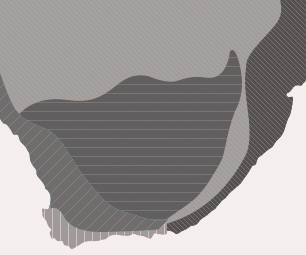






Rate this article
Article well written and informative
Rate this plant
Is this an interesting plant?
Login to add your Comment
Back to topNot registered yet? Click here to register.